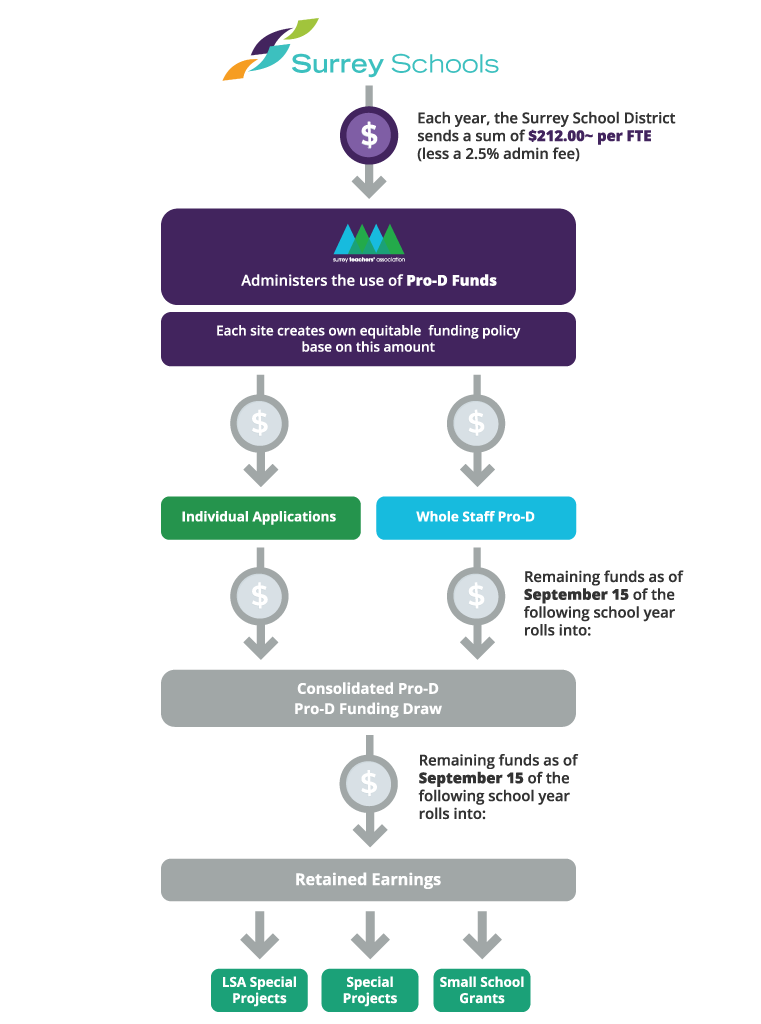I feel that a key piece of understanding this chasm between the amount of technology available and the ACTUAL integration of technology by teachers is to demonstrate the expenditures on technology (both hardware and software) and compare it to the available professional development opportunities. In order to demonstrate the difference in the two levels of spending, I’m going to focus on the largest district in British Columbia, the Surrey School District. It would be a really interesting research topic for someone to undertake examining the expenditures on technology vs the expenditures on teacher’s professional development. While that project is very needed, it goes beyond the scope of this blog post (and beyond the parameters of my project).
According to the Surrey Schools 2024-2025 fact sheet, the district employees 7, 106 teachers (that’s a lot!). In Surrey, teachers are allocated professional development funding from the school district. An allotment of funds are sent from the district to the Surrey Teachers Association (union), who then distribute the funds based on their funding policy. In the 2024-2025 school year, each full time teacher in Surrey is entitled to $212.00 (minus the 2.5% admin fee). So each teacher has $205.70 to spend on professional development for the 2024-2025 school year.

While $200+ per full time teacher sounds like a lot of money, each teacher has the autonomy to decide how to spend their professional development funding. Teachers are not mandated to take specific professional development workshops. They can choose to purchase pedagogical resources, attend workshops, collaborate with colleagues, etc. The autonomy of teachers to choose the area they want to focus on is important and necessary. However, what happens when there’s a noticeable difference in the application of BC’s Digital Literacy Framework and teacher’s integration of technology in their classroom? Should this be handled via professional development workshops? What about in-service learning? How can this critical component be resolved?
Just to put it into perspective, the Surrey School District allocated roughly $1, 507, 108 (estimated using $212/FTE x 7,106) towards professional development for the 2024-2025 school year. This is not a firm number because the Surrey Schools fact sheet only stated how many teachers they employed and not the total number for Full Time teachers.
When searching to understand how much money the Surrey School District spent on technology (both hardware and software) it took a long time to find the information. According to the Statement of Financial Information (SOFI) report from the 2023-2024 school year, the Surrey School district spent over $2 million on new hardware (p. 24 in the 2023-2024 SOFI report) on computer hardware. In the report, they also state how much they spent for specific goods and services if they spent over $25,000. They spent $2,392,723 with Apple Canada and $1,223,972 with Dell Canada which would likely cover both computer hardware and other items like dongles for Apple products, Apple TVs, and items to support the function of the hardware. Either way, it’s a staggering amount of money to be spent in a school year. I am certain there are other companies on the list who also would be a part of the district’s expenditures on computer hardware. These amounts do not include the expenditures for computer software for programs such as Discovery Education or Carnegie Learning which are companies that have software for education. There is a line item in the SOFI report that says “professional development and travel” with an expenditure of $2,731,062 however its unclear how much was spent on each category or if it’s a combined category of the cost to hire professional development guests and pay for their travel expenses. Does this also cover the $212 per full time employee that was sent to the Surrey Teachers Association. Without further clarification it is impossible to determine how to interpret that value.
The purpose of going through the Statement of Financial Information was to highlight the amount of money the school district is spending on hardware and software without a plan for supporting teachers in developing the skills for using both effectively. Both Rosales (2021) and Delgado et al. (2015) are clear to point out in their work that it is necessary for school districts to develop a support plan for supporting teachers in acquiring the skills necessary to integrate technology into their pedagogy. It is not sufficient, nor is it responsible, to simply purchase the technology and hope that teachers use it.
References
Delgado, A., Wardlow, L., O’Malley, K., & McKnight, K. (2015). Educational Technology: A Review of the Integration, Resources, and Effectiveness of Technology in K-12 Classrooms. Journal of Information Technology Education: Research, 14, 397–416. https://doi.org/10.28945/2298
Rosales, L. K. (2021). Technology Integration: Implication for Teachers’ Professional Development ISSN: 2435-5240 The Southeast Asian Conference on Education 2021: Official Conference Proceedings. 55–68. https://doi.org/10.22492/issn.2435-5240.2021.5
Surrey School District. (September 2024). Surrey Schools Fact Sheet. https://www.surreyschools.ca/page/72/about
Surrey School District. (November 26, 2024). Statement of Financial Information. https://media.surreyschools.ca/media/Default/medialib/2023-2024-sofi-statement-of-financial-information.e9dc73180780.pdf

Recent Comments